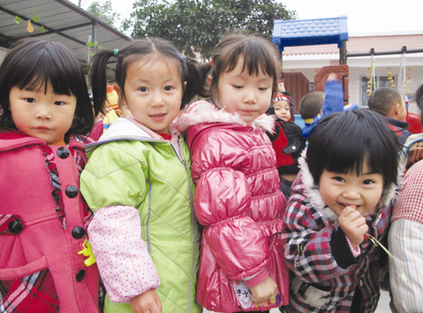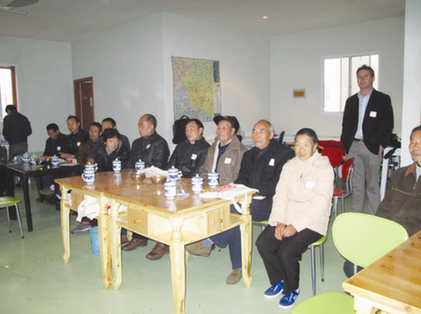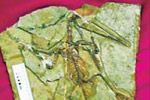Society
Rising from the rubble
Updated: 2011-01-19 07:55
By Chitralekha Basu (China Daily)
|
 Children at Di Kang Le kindergarten, rebuilt after the May 12 earthquake of 2008, in Guangji, Sichuan province. Photos by Chitralekha Basu / China Daily |
|
 Senior citizens attend a grassroots groups' meeting at Di Kang Le community center. |
A rebuilt kindergarten, that was flattened in the Sichuan quake, now serves as a platform for coordinating the work of grassroots organizations and NGOs. Chitralekha Basu reports.
Kang Yuling, principal of Di Kang Le kindergarten in Guangji, Sichuan province, recalls the afternoon of May 12, 2008 in graphic detail. "The kids were in the dorm, taking their afternoon nap. They are usually up by 2:30 pm," she says.
"The tremor struck at 2:28. Fissures appeared on the walls. The place was suddenly filled with a dusty swirl."
As a local who had taught at Di Kang Le for more than 25 years - she taught most of the current children's parents - Kang was no stranger to quakes. Located not far from the seismic belt along Mount Longmen in Mianzhu county, Guangji has been shaken up before. She had no idea of the scale of the disaster in the offing, but her first impulse was to get the students to safety.
Kang and her husband quickly roused the kids - all 150 of them - from their state of half-stupor, wrapped them in blankets and brought them out in the open. Within the next few minutes, two wings of the school had collapsed.
Two-and-a-half years down the line, Di Kang Le kindergarten looks like any other pre-primary school in a small Chinese town. The kids, romping around the expanded play area, giggle and flash victory signs when photographed. Large images of fish swim among the painted waves on the walls, flanked by sunflowers with a smiley face. The dorm, housed in the newly-built wing, has cute bunk beds. Gas from waste recycling in a pit is used in the kitchen.
But there is more to this joyous story than meets the eye. For Di Kang Le is not just a school that survived the quake that killed 68,000 people and left at least 12 million homeless and was built anew from a rubble heap. Today it serves as a platform, a meeting ground, for local grassroots groups and NGOs - expatriate and local - who wish to work toward better lives for people in Sichuan.
"The quake acted as a catalyst," says Peter Goff, chairperson of Sichuan Quake Relief (SQR), a group that launched a full-on drive in the area to reach relief within hours of the first major quake on the afternoon of May 12, and has since adopted Di Kang Le. "These local grassroots groups, working in different areas of social development - attending to children with cerebral palsy, for instance - came into focus because of the attention on the quake."
A slew of these grassroots groups met recently at Di Kang Le's newly-built Spartan but functional community center to take part in a day-long workshop, coordinated by SQR vice-chair Catherine Platt. "We were impressed by the enthusiastic participation of local grassroots groups," Platt says. "Their discussion of strengths and opportunities, in particular, is an encouraging indicator of future potential."
Gao Guizhi was the prime mover behind the capacity-building sessions for NGOs held on Dec 2. A former official with the Sichuan provincial government who always wanted to do more than what his role as a public servant allowed him to, Gao had set up the 512 Center on 15 May, 2008, as an umbrella organization, coordinating and supporting the activities of the NGOs working for those affected by the quake. There were 20 participants in all, including groups from Beijing, Shaanxi, Guizhou and Shanghai, who joined in solidarity.
"The idea," Gao says, "was to reach out to more local NGOs, make people aware of a citizen's rights in civil society and the role played by an NGO in that context."
At the maiden session of the grassroots groups' meeting at the Di Kang Le community center, Gao kept the audience entertained as he outlined the scope and possibilities for NGO work. "Speaking to an audience of senior citizen support groups and farming cooperatives that may not have previously considered themselves to be an NGO," as SQR director David Hunt puts it, Gao reiterated the need for such organizations, even in a country like China where the government's role in disaster management is exemplary.
"The Chinese government did more than any other could have possibly done, faced with such a crisis," agrees Peter Goff, even as he appreciates the readiness with which the government welcomed outside support. "You are talking about an area the size of Germany and a homeless population of 12 million plus. The scale is so huge that there are bound to be people who fall through the cracks. The local NGOs and we can help fill those gaps and that's what the government realizes," he says, acknowledging the unusually fast pace at which he got clearances from the local and provincial governments before SQR could come on the board of Di Kang Le, build it anew and then use it as the epicenter of relief and recovery-related activities, as well.
The space doubles as a temporary meeting place for the village senior citizen's association. Here they play mahjong, socialize, sort out problems for individuals and also serve as effective links for people wishing to get in touch with government officials, some of them having worked for the government. It's also a venue for holding "fun community-building events" says Hunt, like film shows and football matches. For a community that has been through unrelenting physical and mental trauma since the May 12 quake and the several aftershocks, "an organized event in a warm place where they can chat over a cup of tea" can be wonderfully rejuvenating, he adds.
What began as a localized endeavor, catering to around 1,500 people from six villages in the neighborhood, has now taken wings. As Tu Qiuju, coordinator of the local NGO Disaster Preparedness Center, who participated in the workshop, says of the maiden capacity-building meet, "This kind of meeting helps grassroots organizations look beyond the local area and generate creative ideas that might work for others as well."
"Hopefully, by next year, SQR should be self-sufficient, run entirely by locals," says Hunt. Going by the intense networking and good vibes doing the rounds, the beneficiaries of their efforts may not be restricted to Sichuan alone.
Specials

President Hu visits the US
President Hu Jintao is on a state visit to the US from Jan 18 to 21.

Ancient life
The discovery of the fossile of a female pterosaur nicknamed as Mrs T and her un-laid egg are shedding new light on ancient mysteries.

Economic Figures
China's GDP growth jumped 10.3 percent year-on-year in 2010, boosted by a faster-than-expected 9.8 percent expansion in the fourth quarter.